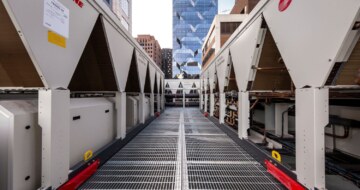
November 10, 2025 in Advisory Notes
Mandatory Climate Reporting and the Role of Buildings
Mandatory climate-related risk and opportunity reporting is a new Australian regulatory requirement for large companies to disclose how climate change...
November 25, 2022

The race to practical completion on many new projects can lead to compromises in quality, rushed commissioning and incomplete integration of systems. A comprehensive tuning program can mitigate the impact of unresolved issues that appear as a result of programme pressures. It can also help identify and resolve legacy issues within existing buildings, where well-intentioned changes may have been made without consideration of the downstream impact on building performance.
The scope of building tuning can vary between new and existing buildings and depends on the building owner’s requirements (e.g. a NABERS commitment agreement, Green Star Rating, improved tenant satisfaction, etc.). However, the specification of building tuning is often left to the reader’s imagination. Without a specific tuning scope and the active engagement of facility management, the building tuning process can fall short of its potential. References to tuning, “in accordance with” Green Star or LEED Guidelines can lead to differences in expectations.
Requires a strong and coordinated facility team effort involving the building owner, facility manager, occupants, service providers and technical tuning experts. In recent times, the roles of analytics packages and ‘virtual engineers’ has also played a part in the building tuning process. Operational analytics packages can save tuning teams a great deal of time and provide detailed insights into the performance of building systems. Many analytics packages have pre-configured rules or algorithms to identify common issues. It is critical that the ‘rules’ used to identify performance issues are specific to the building and tuned to remove ‘noise’ and spurious alarms.
The availability and accessibility of building information is also impacting building tuning. This includes integrated asset management systems, pro-active maintenance routines, life cycle planning, BIM Models incorporating O&M Documentation. Making this information readily available to building tuning teams can help to make fast, informed decisions and significantly improve the effectiveness of the tuning process.
Buildings exist to provide a comfortable, safe and functional space for occupants. The first goal of building tuning should be to make sure that the occupied spaces are meeting the expectations of the occupants and/or lease. Seeking feedback from occupants is an extremely valuable source of information.
Are the current control strategies and control loops operating in a stable, reliable and repeatable manner? Reducing instability can lead to better system performance, lower energy use and less wear on plant. Instability can be a result of:
Energy and water use in facilities is not ‘set and forget’; an accurate energy metering and energy efficiency strategy and reporting system is essential, along with making it someone’s job to pay attention! Energy usage dashboards can be very useful tools. Ensure that the energy and water use data is trended at appropriate intervals to allow for accurate assessment of hourly/daily/monthly/annual usage.
Targeted maintenance strategies should be implemented based on tuning observations, to help investigate issues and ensure ongoing efficient operation of the plant. The maintenance team should be involved in identifying additional improvement opportunities and feeding this back to the tuning team.

For more information about Building Tuning, contact:
John Bourne, A.G. Coombs Advisory | T: +61 7 3648 0500, E: jbourne@agcoombs.com.au
Michael Sue, A.G. Coombs Advisory | T: +61 2 9248 7400, E: msue@agcoombs.com.au
Andrew Smith, A.G. Coombs Advisory | T: +61 3 9248 2700, E: asmith@agcoombs.com.au

November 10, 2025 in Advisory Notes
Mandatory climate-related risk and opportunity reporting is a new Australian regulatory requirement for large companies to disclose how climate change...

October 8, 2025 in Advisory Notes
Electrification projects can be complex undertakings bringing together a range of technical elements along with planning, coordination and logistics c...

September 1, 2025 in Advisory Notes
Cyber security incidents reported against both government and private organisations continue to increase in both frequency and severity.

July 15, 2025 in Advisory Notes
During COVID-19 many buildings experienced a significant reduction in the number of occupants. With the move to remote working, the reliance on tenant...